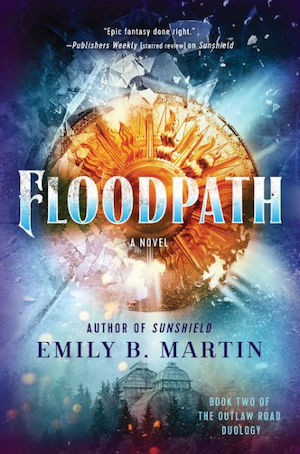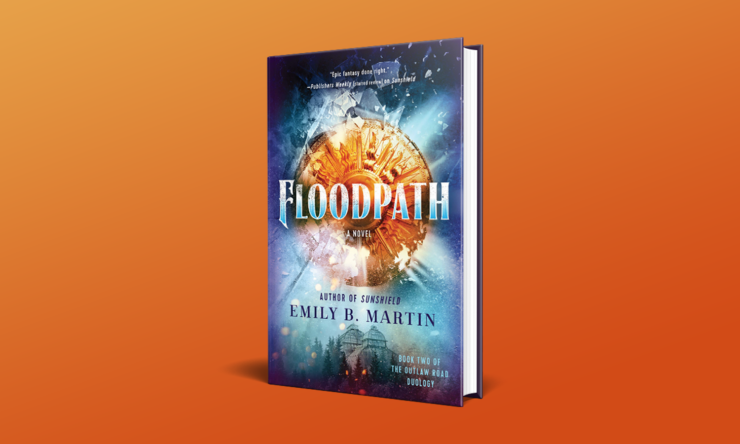Not long before the pandemic struck last year, I began playing a video game called Greedfall. That the overarching plot involved a country grappling with a pandemic ended up putting a lengthy pause on my own progress through the game, but there was one main feature that attracted me to it: the idea of an open-world fantasy game in which diplomacy was as important as casting the right spell or having a suitably dangerous weapon.
Hence the appeal of Emily B. Martin’s Outlaw Road Duology, a pair of novels set in a fantasy world with a geography that takes its cues from—as Paul Weimer noted in his review of the first book, Sunshield—North America. Both Sunshield and Floodpath are narrated by a distinctive trio of characters. Lark, a Robin Hood-by-way-of-Sergio Leone bandit who targets the wealthy and those invested in human trafficking, is the most archetypal of the three. Veran, a young noble acting as a diplomat, is a less familiar figure; so too is Tamsin, an ashoki—essentially, a kind of court poet and musician whose works can help shape government policy.
When Sunshield concluded, all three narrators faced individual challenges. Veran’s epilepsy ends up being a particular challenge when maneuvering through barely-habited regions in inhospitable weather. Tamsin, who spent most of Sunshield in the custody of kidnappers, has to struggle with an injury to her tongue that makes speech difficult and leaves her questioning her future. And Lark wrestles with the discovery that she’s the long-lost child of the royal family of Lumen Lake—something entirely at odds with her sense of herself as a self-made warrior against the rich and powerful. There’s also plenty of palace intrigue here. Tamsin’s abduction ties in with a contentious debate in the powerful nation of Moquoia over ending slavery.
The two questions looming over the proceedings once Floodpath begins relate to plots. Just who was conspiring in Moquoia to take Tamsin out of the picture and infect Eloise, Lumen Lake royalty and part of a diplomatic mission, with disease? And how did Lark, whose family had previously believed that she was dead, become an infamous outlaw?
Buy the Book


Floodpath
Much of this book follows its trio of narrators as they attempt to sort out these answers. They’re joined by some allies, including Iano, prince of Moquoia and Tamsin’s beloved, and Soe, a friend of Tamsin’s who, narratively speaking, provides a sense of how things are going in the wider world. Martin manages these plot threads well, giving a good sense of balance between the different subplots and effectively using the transitions from one narrator to the next to create suspense.
This is not, however, a narrative where the plot turns particularly twisty; the identity of the principal figure in the conspiracy within Moquoia isn’t terribly surprising, if only because there aren’t too many supporting characters who would be in a position to conspire.
While the plotting here is solid and straightforward, it’s in the small details of the world these characters inhabit where Martin makes the strongest impression. In an early moment in Sunshield, Colm, the academic who’s something of a mentor to Veran, warns his students about the dangers of ethnocentric bias. Martin has, essentially, created a world in which more modern intellectual concepts coexist with a more archaic (to the reader, anyway) level of technology. Characters travel by coach or horse, and a significant moment in Floodpath involves one character essentially figuring out what movable type is. On paper, that might seem like a strange achievement, but in terms of the novel’s storyline, it has a substantial impact.
The character work in Floodpath also falls along subtly interesting lines. Lark and Veran spend much of the book pondering their growing attraction to one another, while Tamsin and Iano reckon with the idea that what they’d believed to be True Love might be something different, though no less impactful on them.
Floodpath brings together some familiar elements—palace intrigue, an unlikely figure with a royal birthright, a group of young heroes facing impossible odds—but finds largely unpredictable ways to let them play out. It’s a novel where an idea can be as strong as an army, and where the environment is key to the proceedings (Given her background as a park ranger, it’s not surprising that Martin is particularly skilled at making the different nations feel lived-in in a tactile, experiential way). Floodpath brings this duology to a close deftly, with a number of fascinating adjustments to familiar tropes.
Floodpath is available from Harper Voyager.
 Tobias Carroll is the managing editor of Vol.1 Brooklyn. He is the author of the short story collection Transitory (Civil Coping Mechanisms) and the novel Reel (Rare Bird Books).
Tobias Carroll is the managing editor of Vol.1 Brooklyn. He is the author of the short story collection Transitory (Civil Coping Mechanisms) and the novel Reel (Rare Bird Books).










